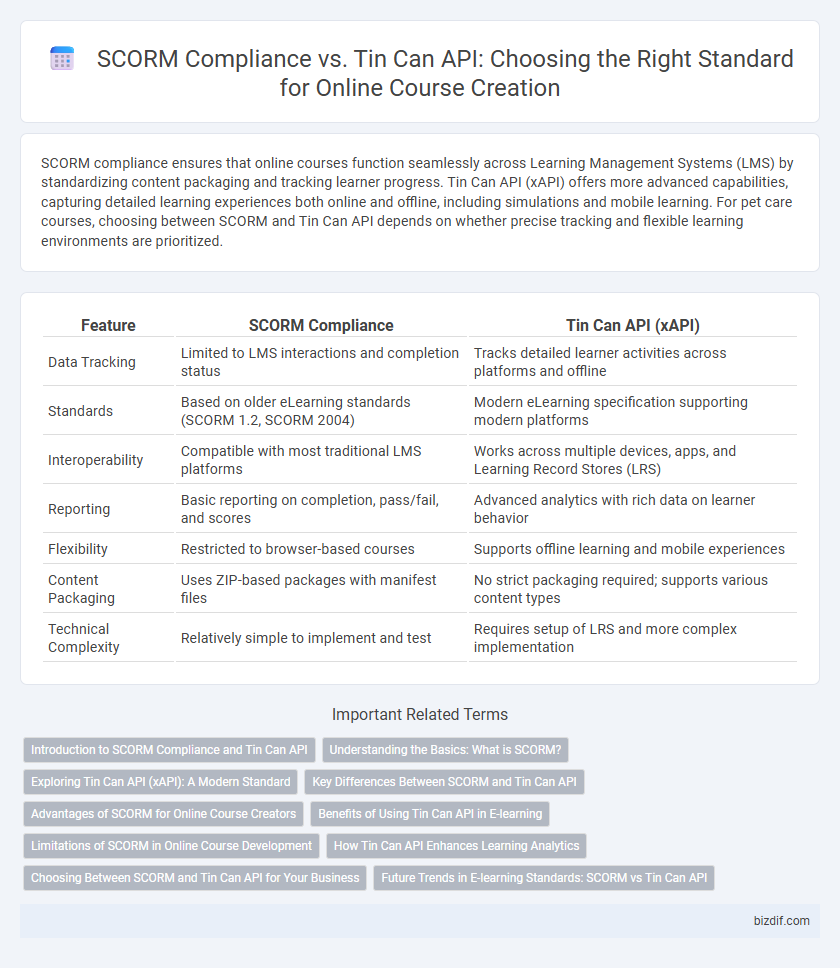SCORM compliance ensures that online courses function seamlessly across Learning Management Systems (LMS) by standardizing content packaging and tracking learner progress. Tin Can API (xAPI) offers more advanced capabilities, capturing detailed learning experiences both online and offline, including simulations and mobile learning. For pet care courses, choosing between SCORM and Tin Can API depends on whether precise tracking and flexible learning environments are prioritized.
Table of Comparison
| Feature | SCORM Compliance | Tin Can API (xAPI) |
|---|---|---|
| Data Tracking | Limited to LMS interactions and completion status | Tracks detailed learner activities across platforms and offline |
| Standards | Based on older eLearning standards (SCORM 1.2, SCORM 2004) | Modern eLearning specification supporting modern platforms |
| Interoperability | Compatible with most traditional LMS platforms | Works across multiple devices, apps, and Learning Record Stores (LRS) |
| Reporting | Basic reporting on completion, pass/fail, and scores | Advanced analytics with rich data on learner behavior |
| Flexibility | Restricted to browser-based courses | Supports offline learning and mobile experiences |
| Content Packaging | Uses ZIP-based packages with manifest files | No strict packaging required; supports various content types |
| Technical Complexity | Relatively simple to implement and test | Requires setup of LRS and more complex implementation |
Introduction to SCORM Compliance and Tin Can API
SCORM compliance ensures e-learning content is compatible with most Learning Management Systems (LMS), standardizing course structure, tracking, and reporting learner progress. Tin Can API (Experience API or xAPI) extends SCORM capabilities by capturing rich data on diverse learning experiences both online and offline, enabling detailed analytics beyond traditional course completion metrics. Together, SCORM and Tin Can API represent essential standards in online course creation for effective content interoperability and comprehensive learner activity tracking.
Understanding the Basics: What is SCORM?
SCORM (Sharable Content Object Reference Model) is a set of technical standards for e-learning software products, enabling interoperability between online courses and learning management systems (LMS). It defines how content can be packaged into a transferable ZIP file and tracked for completion, scores, and learner progress. SCORM compliance ensures courses can run seamlessly across various LMS environments, though it has limitations in tracking detailed learner experiences compared to newer standards like Tin Can API (xAPI).
Exploring Tin Can API (xAPI): A Modern Standard
Tin Can API (xAPI) offers advanced tracking capabilities beyond traditional SCORM compliance, enabling detailed monitoring of diverse learning experiences across multiple platforms and devices. It supports real-time data reporting and captures informal, social, and offline learning activities, enhancing the depth of learner analytics. Widely adopted in modern e-learning environments, Tin Can API ensures flexible, interoperable course content that drives personalized and adaptive learning strategies.
Key Differences Between SCORM and Tin Can API
SCORM compliance ensures standardized tracking and reporting of e-learning content within most Learning Management Systems (LMS), focusing on course completion, scores, and time spent. Tin Can API, also known as Experience API or xAPI, extends SCORM's capabilities by capturing a wider range of learner experiences, including offline activities and mobile learning, with detailed statements about learning actions. The key differences include Tin Can API's flexibility in data collection, improved interoperability, and support for diverse learning environments beyond traditional LMSs.
Advantages of SCORM for Online Course Creators
SCORM compliance ensures seamless integration and interoperability across numerous learning management systems, simplifying course deployment for online course creators. Its standardized structure tracks learner progress and completion data efficiently, supporting robust reporting and consistent user experiences. SCORM's wide adoption and proven reliability make it a dependable choice for creating scalable and accessible e-learning content.
Benefits of Using Tin Can API in E-learning
Tin Can API offers advanced tracking capabilities beyond SCORM, capturing a wide range of learner activities both online and offline for comprehensive data analysis. This flexibility supports diverse learning experiences, including mobile and social learning, enhancing engagement and knowledge retention. Its interoperability with multiple platforms ensures seamless integration and real-time reporting crucial for effective e-learning management.
Limitations of SCORM in Online Course Development
SCORM compliance in online course creation faces limitations such as restricted tracking capabilities, inability to capture complex learning experiences, and limited support for offline access. Unlike Tin Can API (xAPI), SCORM cannot fully track learner interactions beyond standard quiz scores and completion rates, hindering detailed data collection for adaptive learning. These constraints make SCORM less suitable for modern, mobile, and experiential learning environments requiring comprehensive analytics and flexible content delivery.
How Tin Can API Enhances Learning Analytics
Tin Can API, also known as Experience API (xAPI), significantly enhances learning analytics by tracking detailed learner interactions across multiple platforms, unlike SCORM's limited data collection within a single LMS environment. It captures real-time data on diverse learning experiences such as mobile learning, simulations, and social interactions, providing comprehensive insights into learner behaviors and progress. This advanced tracking capability enables educators to personalize instruction, measure engagement more accurately, and improve course effectiveness through data-driven decisions.
Choosing Between SCORM and Tin Can API for Your Business
SCORM compliance ensures broad compatibility across most Learning Management Systems (LMS), making it ideal for businesses requiring standardized content delivery and tracking. Tin Can API (xAPI) offers advanced data collection, enabling detailed learner behavior analysis and offline activity tracking, which benefits organizations aiming for deeper insights and flexibility in training. Selecting between SCORM and Tin Can API depends on the business's need for interoperability versus sophisticated analytics and mobile or offline learning capabilities.
Future Trends in E-learning Standards: SCORM vs Tin Can API
The evolution of e-learning standards highlights a shift from SCORM compliance, which offers basic tracking within Learning Management Systems, to the Tin Can API (xAPI), enabling detailed data capture from diverse learning experiences beyond traditional courses. Tin Can API supports advanced analytics, mobile learning, and offline activity tracking, making it the preferred standard for future-proofing online course creation. Embracing Tin Can API ensures interoperability and richer learner insights, driving innovation in adaptive and personalized learning environments.
SCORM compliance vs Tin Can API Infographic

 bizdif.com
bizdif.com